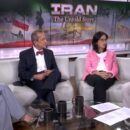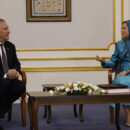Iran: World must take meaningful action against bloody crackdown as death toll rises

Iran: World must take meaningful action against bloody crackdown as death toll rises
Amnesty International | September 23, 2022
The bravery of protesters facing a spiralling deadly response by the Iranian security forces over the past days after the death of Mahsa Amini reveals the extent of outrage in Iran over abusive compulsory veiling laws, unlawful killings, and widespread repression, Amnesty International said today.
Evidence gathered by the organization from the past two nights of fresh violence in 20 cities and 10 provinces across Iran points to a harrowing pattern of Iranian security forces deliberately and unlawfully firing live ammunition at protesters. With the death toll reaching at least 30 people, four of them children, the organization reiterated its calls for urgent global action, warning of the risk of further bloodshed amid a deliberately imposed Internet black out.
On the night of 21 September alone, shootings by security forces left at least 19 people dead, including at least three children. Amnesty International has reviewed photos and videos showing deceased victims with horrifying wounds in their heads, chests and stomachs.
“The rising death toll is an alarming indication of just how ruthless the authorities’ assault on human life has been under the darkness of the internet shutdown. There is no such thing as “an impartial investigation” within Iran. UN member states must go beyond toothless statements, hear the cries for justice from victims and human rights defenders in Iran and urgently set up an independent UN investigative mechanism,” said Heba Morayef, Middle East and North Africa Director at Amnesty International
The anger expressed on the streets has also shown how Iranians feel about the omnipresent so-called ‘morality police’ and compulsory veiling laws. It is high time for these discriminatory laws and the security forces enforcing them to be completely removed from Iranian society, for once and for all.
Heba Morayef, Amnesty International
“The anger expressed on the streets has also shown how Iranians feel about the omnipresent so-called ‘morality police’ and compulsory veiling laws. It is high time for these discriminatory laws and the security forces enforcing them to be completely removed from Iranian society, for once and for all.”
Amnesty International has recorded the names of 19 people including three children shot dead by security forces on 21 September. The deaths of a further two people, including a 16-year-old bystander, have also been confirmed on 22 September. Further deaths are being investigated.
Echoing growing frustration at the international community’s failure to take meaningful action to address successive waves of protest killings in Iran, the father of Milan Haghigi, a 21-year-old man killed by security forces on 21 September, told Amnesty International: “People expect the UN to defend us and the protesters. I, too, can condemn [the Iranian authorities], the whole world can condemn them but to what end this condemnation?”
According to eyewitness accounts, security forces involved in the deadly shootings include Revolutionary Guards agents, paramilitary Basij forces and plainclothes security officials. These security forces have fired live ammunition at protesters with the intention of dispersing, intimidating and punishing them or preventing them from entering state buildings. This is prohibited under international law which restricts the use of firearms to instances where their use is necessary in response to an imminent threat of death or serious injury, and only when less extreme means are insufficient.
In addition to the 19 people killed on 21 September, Amnesty International has recorded the names of two other people killed by security forces in Dehdasht, Kohgilouyeh and Bouyer Ahmad province on 22 September, including a 16-year-old bystander.
Since nation-wide protests were triggered by the death in police custody of 22-year-old Mahsa (Zhina) Amini after being violently arrested by Iran’s “morality police” in connection with discriminatory and degrading compulsory veiling laws, Amnesty International has recorded the names of 30 people killed by security forces: 22 men, four women and four children. The organization believes the real death toll is higher and investigating further.
Deaths were recorded in Alborz, Esfahan, Ilam, Kohgilouyeh and Bouyer Ahmad; Kermanshah; Kurdistan, Manzandan; Semnan; Tehran, West Azerbaijan provinces.
West Azerbaijan province
This province had one of the highest tolls on the night of 21 September with the death of at least three men and two children. They include Sadrodin Litani, Milan Haghighi and 16-year-old Amin Marefat in Oshnavieh; and Danesh Rahnama and 17-year-old Abdollah Mahmoudpour in the village of Balou.
A human rights defender shared with Amnesty International the written account of a protester from Ohshnavieh who described how on 21 September, Revolutionary Guards agents randomly fired live ammunition at protesters while they were attempting to enter the Office of the Governor. The protester said: “Revolutionary Guards agents attacked people and as a result of shooting directly [towards protesters] with firearms, three people lost their lives… They included Sadroddin Litani, who was shot in his stomach and neck from a distance of several metres and Amin Marefat who was shot in his heart … the bullet exited through his back.”
Amnesty International reviewed a corroborating video showing a bullet hole in the back of Amin Marefat’s dead body.
The father of the third victim from Oshnavieh, Milan Haghighi, told Amnesty International that he died from fatal gunshot wounds including in his leg and torso.
According to information shared with Amnesty International by human rights defenders with contacts on the ground, the deadly shootings in the village of Balou took place in front of the Basij headquarters there. The organization obtained a voice message from an eyewitness saying: “They [security forces] are directly killing us.”
Kohgilouyeh and Bouyer province
Two eyewitnesses from Dehdasht told Amnesty International that 16-year-old bystander, Pedram Azarnoush, was shot dead on 22 September after Revolutionary Guard agents began repeatedly randomly firing live ammunition to disperse protesters. The same night, locals said security forces had killed a second man identified as Mehrdad Behnam Vasl.
One of the two eyewitnesses told Amnesty International: “The young boy was leaning on a wall and he was only looking at people. The protesters were fleeing, and he did not realize that bullets could come in his direction as well … The security forces were repeatedly firing their weapons in all directions, and everyone was at risk of being shot or not, it was sheer luck whether they [escaped] being hit by a bullet or not.”
The eyewitnesses said the Revolutionary Guards forces had hidden among trees in a square in Deshdasht and faced no threat when they began shooting at chanting protesters.
Witnesses said several people also sustained serious gunshot wounds from security forces firing live ammunition, including a 13-year-old boy, Amirali Douhandeh, who was shot in the leg. They reported that security and intelligence officials have established a strong presence at Emam Khomeini hospital in Dehdasht, heavily guarding a section where injured protesters are being treated.
Semnan province
Information gathered about Garmsar, Semnan province points to a similar pattern of reckless shooting by security forces resulting in the death of at least one young protester, Mehdi Asgari, on 21 September in front of a police station.
In video footage purportedly of the incident, which was circulated online, protesters are seen coming under fire while throwing stones at the police station and kicking its entrance door. Amid the sound of gunfire, two protesters are seen falling to the ground. A second video from the same incident reviewed by Amnesty International shows one protester lying lifeless and bleeding on the ground.
Mazandaran province
At least six men and one woman are recorded as having been killed in this province. Their names are Mohsen Mohammadi killed in Ghaemshahr; Hannaneh Kia, Hossein Ali Kia and Mehrzad Avazpour killed in Noshahr; Mohammad Hosseinikhah killed in Sari; Milad Zare killed in Babol; and Amir Norouzi killed in Bandar-e Anzali.
A journalist reported that according to two friends of Hannaneh Kia, she was fatally shot on her way from a doctor’s visit.
Methodology
To investigate the ongoing protest crackdown, Amnesty International has so far spoken to and received audio-visual evidence from 30 individuals including 10 eyewitnesses, six protesters and one victim’s relative as well as four human rights defenders and nine journalists outside in Iran who were in turn in contact with primary sources on the ground.









